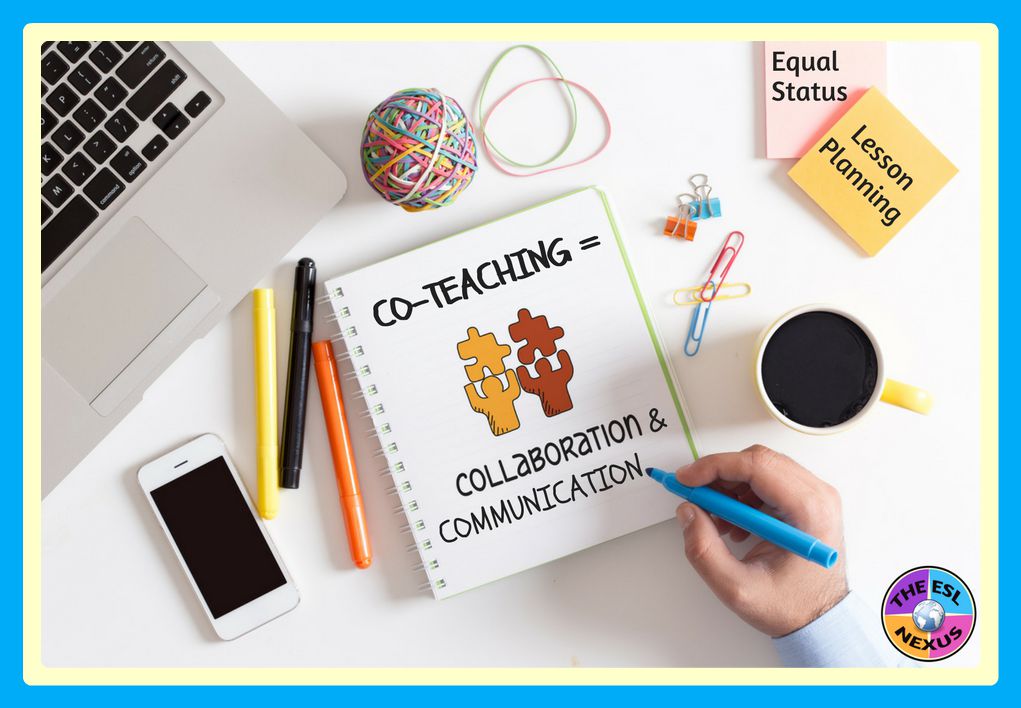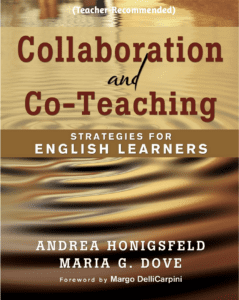Being a co-teacher can be a joy or something to dread. Which of these actual teaching situations would you prefer to be in:
Co-Teaching Scenarios
Class A, a 4th grade Language Arts class
The ESL teacher goes into the regular education class and sits in the empty desk next to the only English Language Learner in the room. The regular ed teacher at the front of the classroom explains the reading and writing task to the class. As the ESL teacher passes out a worksheet to all the students, she listens carefully to find out what the lesson is about. Then she returns to her seat beside her ELL and answers any questions the girl has about the work.
Class B, a 6th grade Language Arts class
The ESL teacher goes into the regular education class and stands at the front of the room, near the other teacher, as agreed upon the day before. As the regular ed teacher introduces the daily language task, the ESL teacher passes out the worksheet for it. While the students are working, both teachers circulate and check on the 3 ELLs in the class as well as the other students. The ESL teacher leads the class as students volunteer answers and the regular ed teacher writes the correct responses on the board.
What is Co-Teaching?
If you’re like me, Class B wins hands down. Before I explain why Class B is a better model of co-teaching, I want to give you my definition of the term.
 |
| What successful co-teaching looks like; source: The ESL Nexus |
Co-teaching means there is more than one teacher in a classroom and teaching the lesson is done jointly by both teachers. Usually, one teacher is a specialist with expertise in a particular area and the other is a regular ed teacher. Sometimes there may even be 3 teachers in the room — the regular ed teacher, an ESL teacher, and a special education teacher.
In the ideal co-teaching situation, all teachers are equally important. They plan instruction together, create and grade lessons cooperatively, implement teaching tasks equitably, and share responsibility for all students although the specialist focuses on a particular sub-group. In the co-teaching situations that are most effective, the students cannot tell which teacher is supposed to work with which students because all the teachers work with everyone.
But as you can see from the 2 scenarios above, that doesn’t always happen. There are 4 reasons why Class B is a more successful example of co-teaching.
 |
| Successful co-teachers embody these characteristics; source: The ESL Nexus |
Communication
In Class B, I knew in advance what the lesson was going to be because I talked about it with the other teacher during our common planning time. We decided who was going to implement each part of the lesson so, when I arrived at the class, I immediately knew what I had to do. In Class A, I found out what the lesson was only after I got there; we didn’t have common planning time and the other teacher didn’t respond promptly to my email messages.
* In my view, frequent communication with the other teacher(s) is the single most important factor to ensuring a successful co-teaching situation.
Position and Status in the Classroom
In Class B, I was at the front of the room, just like the other teacher. This showed the students that I had equal status with the regular ed teacher. In Class A, by sitting at a student desk, I was, in a metaphorical sense, lowering myself to the level of another student. Both teachers need to be aware of the non-verbal signals given to students based on where the ESL teacher sits or stands.
* When co-teaching, it’s important for the teacher who enters the room to be seen by students as having the same status as the mainstream teacher. The specialist teacher shouldn’t stand at the back of the room or remain seated next to a student for the entire period — that gives the impression she’s only there in a secondary position because all attention will be focused at the teacher at the front of the class instead.
Working with Students
In Class B, although my main focus was, naturally, on the ELLs, I worked with any student who needed help. When the class was working independently or in small groups, I first checked in with the ELLs and then went around the room and answered questions or gave support to other students. After doing that regularly, the native English speakers just as often asked me for help as they did their mainstream teacher because I was seen as just another teacher, not the ESL teacher. And if I was in another part of the room when an ELL had a question and the regular ed teacher was closer, she helped the ELL instead of calling me over, and then checked with me soon after if she wasn’t sure about her response. The regular ed teacher and I complemented each other in terms of our expertise, to the benefit of everyone.
* By supporting all students in the class, ELLs will feel less singled out and less self-conscious about being different. At the same time, the other students will see that the ESL teacher is just as much a teacher as their regular ed teacher and their ELL classmates are students just like them, which fosters a more positive classroom community and enhances learning for everyone.
Implementing Lessons
In Class B, both teachers took turns leading the class. We split the tasks and each of us had something to do for each part of the lesson. If one of us was talking, the other was writing on the board or distributing papers. It eventually got to the point where I was comfortable jumping in and interrupting the other teacher to clarify something for the ELLs without asking first because I knew she’d be okay with that. In Class A, however, I never provided whole-class instruction and I knew that teacher didn’t want me saying anything to the students unless I asked her first in private if it would be okay.
* The mark of a true co-teaching situation is equitably sharing the implementation of the lesson. This means planning the lesson together and making sure it’s differentiated appropriately, deciding who is going to teach which parts of the lesson, and then sharing the grading of the students’ work.
 |
| Recommendations for successful co-teaching; source: The ESL Nexus |
Tips from Other Teachers
I asked teachers in a few Facebook groups for the one thing they do that helps them be an effective co-teacher. Below are their suggestions. (Click on the green links to go to those teachers’ TpT stores.)
* Communication! Discussing each other’s needs (time, learning outcomes, etc.) and how we can help each other. — Jennifer B. Smith
* Being organized is very important so that the ESL teacher knows what concepts they will need to help co-teach. They might also have levelled resources for those content area lessons which they can use if they know what will be coming up. — Kristy from 2 Peas and a Dog
* I’m an ESOL certified regular ed teacher. I think the regular ed teacher needs to understand that they are also an ESOL teacher. It’s not up to the person pushing in to be the only support ELLs get. I think the ESOL specialist and regular teacher should work together to make sure all instructional activities are modified appropriately. The regular ed teacher needs to make sure and supply curriculum maps, pacing guides, etc. so that the other teacher stays informed and can plan ahead to help better support the students. — The Social Studies Whisperer
* I was lucky to work with an incredible Special Education teacher in a collaboration setting. She and I planned as a team, taught as a team, assessed and retaught as a team, and managed classroom behavior as a team. This provided every student in the classroom two teachers that were both willing and able to help them find greater success. To me, teacher collaboration was the most important factor in assuring growth for all students, not just those assigned to me or to her! — Michele Luck of Michele Luck’s Social Studies
* For us, what has worked is our flexibility and willingness to learn. The co-teaching model depends so much on the content of the class, the needs of the students, the style of each teacher, actually my 3 classes are completely different. It took me some time to learn from the content area teachers, but they were as interested as I was to make it work. — Rocío Filace, a high school ESL teacher of newcomers
* My answer is this: I assume positive intent when collaborating with another teacher in class or when we are planning together. I also try to think of collaboration as a dance. I know we are going to start off awkward and weird. But by the end of the year we will understand each other and will anticipate each other’s moves. — Adriane Hardin-Davis, an ESL teacher living and working in Lexington, Kentucky
* Ella Dickey and Kanako Suwa, a 2nd grade ESL teacher, recommend the following books:
(These are affiliate links. That means that I’ll earn a small commission if you purchase one or both books below but it’s at no additional cost to you. Thanks for your support!)
Final Thoughts
After a while, I dreaded going into Class A. I was essentially a glorified program assistant there. In that teacher’s view, my job was to work with only one student. Unfortunately, she wasn’t interested in developing a more productive relationship with me. If you find yourself in a similar situation, you just have to find little things you can do that benefit your ELLs and focus on working effectively with them.
On the other hand, I loved going into Class B! Significantly, that teacher’s attitude was that I was an asset to her class. She actively solicited my input and I knew she welcomed my ideas. We talked often, shared the workload, and supported all the students in the class regardless of their language background. We had a real teaching partnership and as a result, we were effective and successful co teachers.






